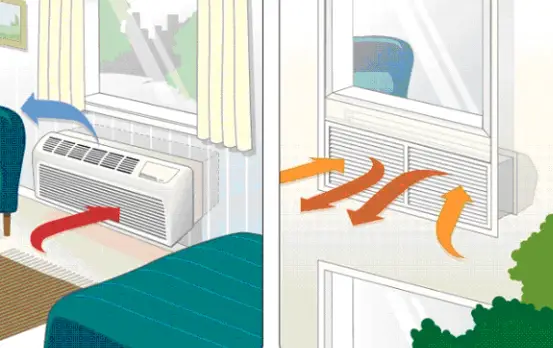Is Ptac Central Air
They say that “knowledge is power,” and when it comes to understanding the different types of air conditioning systems, this adage couldn’t be more true. As a team of experts in the field, we are here to shed light on one specific question that often arises: Is PTAC (Packaged Terminal Air Conditioner) central air? This article aims to provide you with a comprehensive answer, delving into the technical aspects and nuances of PTAC units versus other common cooling systems. Is PTAC Central air in your home?

When it comes to finding the perfect balance between comfort and efficiency, knowing whether PTAC is considered central air becomes crucial. So let’s dive right in! In simplest terms, PTAC air conditioners are not classified as central air systems. While they serve a similar purpose – cooling or heating a space – PTAC units are typically installed through-the-wall in individual rooms or areas.
Unlike traditional central air conditioning systems which distribute conditioned air throughout an entire building via ductwork, PTAC units operate independently and are designed for localized temperature control. Now that we’ve established this distinction, let’s explore further differences between PTACs and HVAC (Heating, Ventilation, and Air Conditioning) systems, along with some common problems associated with PTAC units.
Is PTAC central air
Is PTAC considered to be a form of central air? The answer is no. PTAC, which stands for Packaged Terminal Air Conditioner, is not classified as central air. Central air conditioning systems are designed to cool an entire building or home using a centralized unit that distributes cool air through a network of ducts. On the other hand, PTAC units are self-contained and typically used for individual rooms or smaller spaces.
When it comes to PTAC repair, installation, and maintenance services in New Jersey, there are professionals who specialize in providing these services. Whether you need a PTAC unit repaired or installed, or if you require regular maintenance to keep your unit running smoothly, there are reliable experts available in New Jersey who can assist you. They have the knowledge and expertise to handle any issues that may arise with your PTAC system.
Now transitioning into the subsequent section about ‘PTAC air conditioner,’ it’s important to note that while PTAC units are not classified as central air conditioning systems, they do offer many benefits such as easy installation and individual temperature control.
PTAC Air Conditioner
Imagine yourself stepping into a cool oasis, with a device that brings refreshing breezes straight to your fingertips. PTAC air conditioners are the perfect solution for anyone seeking comfort and convenience in their living or working space. These units, also known as Packaged Terminal Air Conditioners, combine heating and cooling capabilities into one compact system. As a knowledgeable PTAC installer, I can attest to the remarkable efficiency and versatility of these units.
One of the key advantages of PTAC heating and cooling units is their ease of installation and repair. Whether you’re looking for a new unit or need assistance with maintenance or repairs, there are numerous PTAC repair services near you that specialize in these systems. With their expertise, they can ensure that your PTAC air conditioner is properly installed and functioning optimally. Additionally, the compact design of these units allows for flexibility in placement within any room or building layout.
To emphasize the benefits of PTAC air conditioners further, let’s take a look at this 3×3 table:
| Advantages of PTAC Air Conditioners | | ———————————- | | 1. Efficient Heating and Cooling | | 2. Versatile Installation Options | | 3. Convenient Maintenance |
As you can see from this table, PTAC units offer efficient heating and cooling capabilities while allowing for easy installation and maintenance. This combination provides a sense of freedom as you have control over your indoor climate with minimal hassle.
Now let’s delve into the comparison between PTACs and HVAC systems without skipping a beat .
PTAC vs HVAC
When it comes to cooling and heating systems, PTACs offer more versatility and convenience compared to traditional HVAC systems. PTAC stands for Packaged Terminal Air Conditioner, and it is a self-contained unit that can both cool and heat a room. Unlike HVAC systems that require complex ductwork throughout the entire building, PTAC units are installed directly through an exterior wall. This makes them ideal for individual rooms or small spaces where installing ductwork may not be feasible.
One of the main advantages of PTAC units is their ability to provide independent temperature control in each room. With a traditional HVAC system, you have one thermostat controlling the temperature for the entire building, which can lead to uneven heating or cooling. In contrast, PTAC units allow users to adjust the temperature according to their preferences in each individual room. This level of customization ensures maximum comfort and energy efficiency. PTAC heating and cooling units provide efficient temperature regulation, ensuring comfort and convenience year-round.
Moving on to common problems with PTAC units… Read can you put furniture in front of a ptac unit If you want to know about your new furniture.
Common problems with PTAC units
One common issue with PTAC units is that they may not properly cool or heat a room due to a malfunctioning thermostat. This can be frustrating, especially when you’re trying to find relief from the sweltering heat or the bitter cold. When the thermostat isn’t functioning correctly, it can result in inconsistent temperatures and an uncomfortable environment. To address this problem, here are four possible reasons why your PTAC unit’s thermostat might not be working properly:
- Faulty wiring: If the wires connecting the thermostat to the unit are damaged or incorrectly connected, it can cause communication issues and prevent accurate temperature control.
- Sensor problems: The sensor within the thermostat could be faulty or dirty, leading to inaccurate temperature readings and improper cooling or heating.
- Calibration issues: Sometimes, thermostats need calibration to ensure they accurately reflect room temperatures. If not calibrated correctly, your PTAC unit may not provide the desired level of comfort.
- Power supply problems: Insufficient power supply can affect the functionality of your PTAC unit’s thermostat, leading to poor performance.
Dealing with these issues requires technical expertise and knowledge about PTAC systems. However, resolving them will ultimately provide you with more freedom in controlling your indoor climate and creating a comfortable space for yourself and others , which is essential for productivity and overall well-being. By addressing these issues and optimizing your PTAC system, you can enjoy a more efficient and reliable heating and cooling system, saving energy and reducing utility costs. Additionally, a properly functioning thermostat will allow you to easily adjust temperatures to your preference, ensuring a pleasant environment for everyone in the building. If you’re searching any service doing google by ptac air conditioner repair near me. Contact Bluco Mechanical or call us at (929) 447-2077.
Frequently Asked Questions
How does a PTAC unit differ from a traditional central air conditioning system?
A PTAC unit differs from a traditional central air conditioning system by providing individual control, flexibility, and efficiency. It’s ironic how we crave freedom but settle for being controlled by a centralized cooling system.
What are the advantages of using a PTAC unit over a central air conditioning system?
The advantages of using a PTAC unit over a central air conditioning system include cost-effectiveness, individual temperature control, ease of installation and maintenance, and the ability to cool or heat specific rooms rather than the entire house.
Can a PTAC unit be used to cool multiple rooms or areas of a building simultaneously?
Yes, a PTAC unit can cool multiple rooms simultaneously. It functions like a superhero, distributing cool air to different areas of a building. Its precise temperature control ensures each room is comfortable, giving you the freedom to enjoy coolness wherever you go.
What is the typical lifespan of a PTAC unit compared to a central air conditioning system?
The typical lifespan of a PTAC unit is generally shorter than that of a central air conditioning system. However, it’s important to note that PTAC units can provide individualized cooling for multiple rooms or areas simultaneously.
Are PTAC units more energy-efficient than central air conditioning systems?
PTAC units are generally less energy-efficient than central air conditioning systems. They provide cooling and heating to individual rooms, but their design and smaller size result in lower efficiency compared to centralized cooling systems that serve the entire home.



No Comments
Be the first to start a conversation